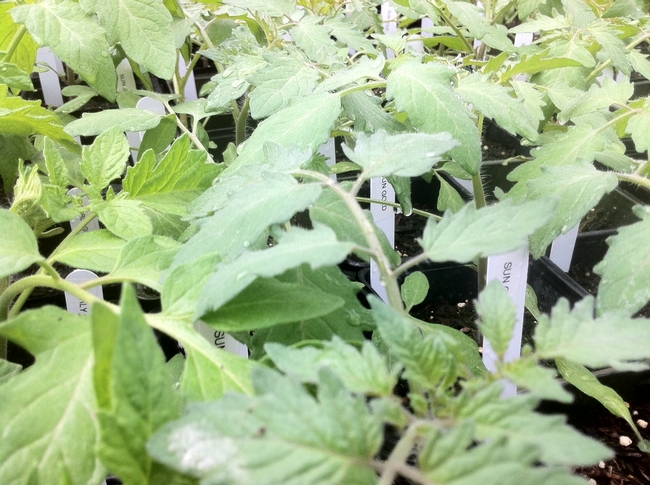
Most importantly, wait to plant until the danger of frost is past and the soil is sufficiently warm. I usually wait until May 1 to plant mine. Prior to planting, be sure to “harden off” the plants by placing them outside for about a week. Put them in a sheltered spot initially, and then gradually expose them to garden conditions. If frost threatens, bring the plants indoors.
Tomatoes need full sun. Choose stocky transplants six to eight inches tall with healthy, green leaves. The seedlings should not be root bound. Water the plants a few hours before planting, and water the planting area prior to planting.Set the plants in the soil so that all but the top two sets of leaves are below ground. Pinch off the lower leaves and avoid handling the stem. New roots will emerge from the buried stem.
If the plants are in biodegradable pots, break up the pots slightly so the roots can easily grow into the soil. Bury peat or paper pots completely to avoid water wicking away from the roots. If your seedlings are in plastic pots, gently remove the plants and loosen the roots. Press the soil firmly around the plant, then water thoroughly.
Tomato plants need plenty of room to grow. If planting in a pot, choose a large one. If you are planting in the ground or in raised beds, space plants 24 to 30 inches apart, assuming the tomatoes will be staked or caged. If the plants are not staked, the tomatoes will need to be farther apart.
Most tomatoes benefit from some type of support. Cages or stakes keep the tomatoes off the ground, allow maximum utilization of garden space, and make harvest easier. I prefer cages and use the collapsible type that I can store neatly over the winter. Place the cages around the tomatoes soon after planting to avoid damaging the plants. Insert two strong stakes to support the cage when the plant becomes heavy with fruit. Check the ultimate height of the tomato variety you are planting to determine the height of the cage required. The openings in the cage should be large enough for hand harvesting.
Some gardeners stake their tomato plants. For this method, select stakes six feet long and one and one-half to two inches wide. Drive them one foot into the soil approximately four to six inches from the plant. As the plants grow, pull the stems toward the stakes and loosely tie them to the stakes at intervals of 10 to 12 inches. Use strips of cloth or some other flexible material. Prune the tomato plants to a few main stems to keep the plants from becoming too heavy.
Tomatoes can also be planted along a fence or large trellis and trained upward as they grow.
Tomatoes need regular watering. They dislike extreme fluctuation in soil moisture, which promotes fruit cracking and blossom end rot. Keep the area weeded. Weeds harbor pests and compete with your tomatoes for nutrients and water. A three-to four-inch layer of mulch will discourage weeds and help retain soil moisture.
Healthy tomato transplants should not need fertilizing until the plants are flowering and fruit are forming. At that point, feed them with nitrogen every four to six weeks, following package instructions. Place the fertilizer around the growing plants in shallow grooves or on the soil surface. Scratch it in and water thoroughly.
For more advice on growing tomatoes, visit the Master Gardener Tomato Plant Sale and Education Day on April 20. You’ll find demonstrations on planting tomatoes, displays on supporting and pruning tomatoes, and information on preserving your harvest.
Tomato Plant Sale: Napa County Master Gardeners are hosting a tomato plant sale on Saturday, April 20, from 9 a.m. to 2 p.m. Choose from 44 varieties that grow well in Napa County. Come early for best selection. Tomato experts will be on hand to answer questions. Location: Oxbow Public Market, south parking lot, 644 First Street, Napa. Plan your purchases with this Quick Guide to Tomato Varieties.
Master Gardeners are volunteers who help the University of California reach the gardening public with home gardening information. Napa County Master Gardeners (http://cenapa.ucdavis.edu) are available to answer gardening questions in person or by phone, Monday, Wednesday and Friday, 9 a.m. to Noon, at the U. C. Cooperative Extension office, 1710 Soscol Avenue, Suite 4, Napa, 707-253-4143, or from outside City of Napa toll-free at 877-279-3065. Or e-mail your garden questions by following the guidelines on our web site. Click on Napa, then on Have Garden Questions?